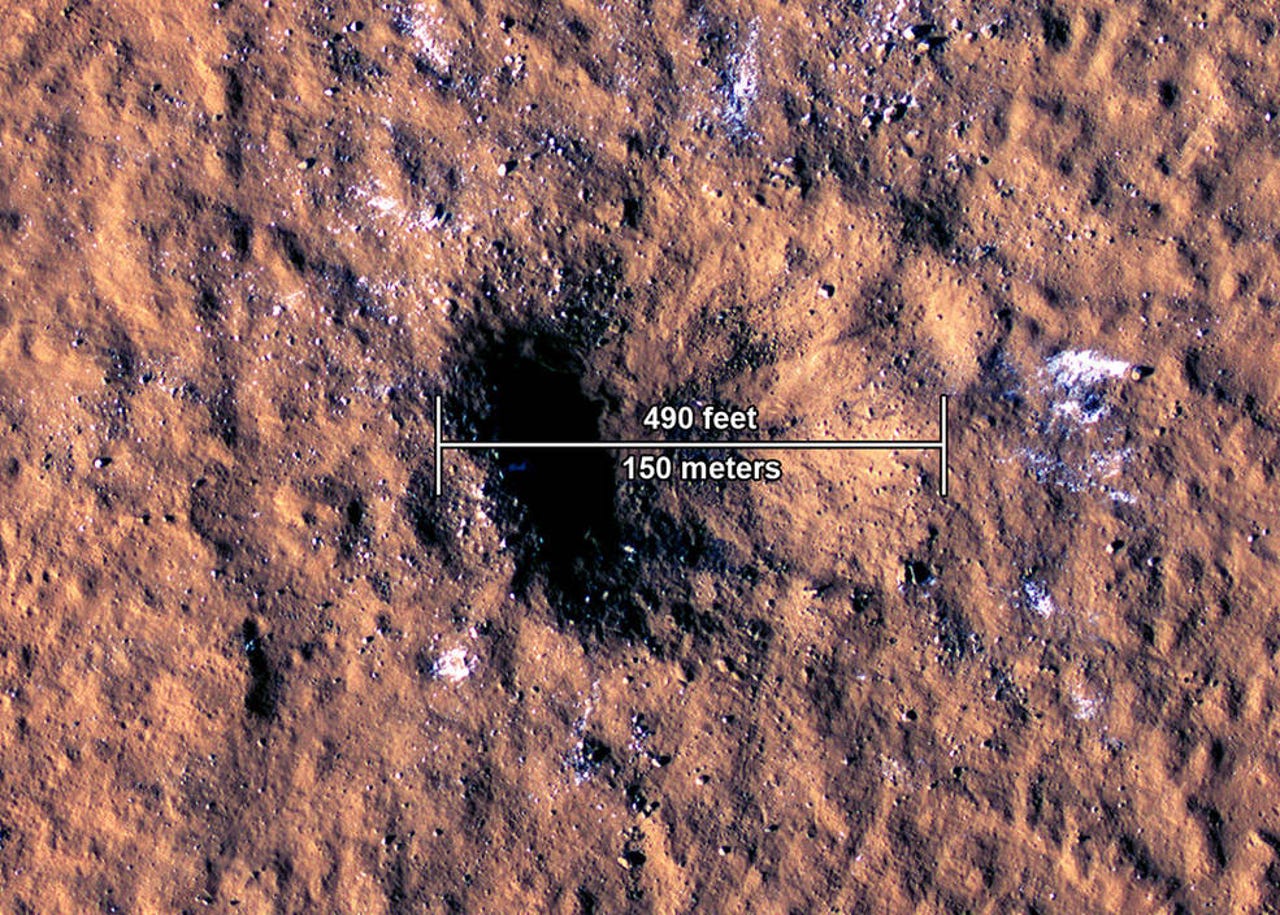
































The impact crater, formed Dec. 24, 2021, by a meteoroid strike in the Amazonis Planitia region of Mars, is about 490 feet (150 meters) across, as seen in this annotated image taken by the High-Resolution Imaging Science Experiment (HiRISE camera) aboard NASA's Mars Reconnaissance Orbiter.
Image: NASA/JPL-Caltech/University of ArizonaNASA on Thursday shared its observations of a meteoriod impact on Mars that occurred last year -by far the largest meteriod impact the agency has observed on the Red Planet, and one that helped reveal new, surprising sources of water ice.
The impact, which happened in December of last year, created a crater about 500 feet wide -about the width of two city blocks, scientists said Thursday. Even though meteorites are hitting Mars all the time, this impact was clearly different, InSight impact science lead Ingrid Daubar told reporters -the crater it left behind is more than 10x larger than the typical new craters that are formed.
Also:NASA: This is the weird sound of a meteoroid hitting Mars
"We thought a crater of this size might form somewhere on the planet once every few decades, maybe once a generation," she said. "So it's very exciting to be able to witness this event."
NASA was able to record the event with multiple tools. The InSight Mars lander first reported the occurrence of a major marsquake on December 24. NASA was able to confirm that it was the result of a meteoriod impact by looking at before-and-after images from its Mars Reconnaissance Orbiter (MRO). The MRO has two cameras on board, both of which were used to study the crater: The Context Camera (CTX) provides black-and-white, medium-resolution images, while the Mars Color Imager (MARCI) produces daily maps of the entire planet for tracking large-scale weather changes.
This meteoroid impact crater on Mars was discovered using the black-and-white Context Camera aboard NASA's Mars Reconnaissance Orbiter. The Context Camera took these before-and-after images of the impact, which occurred on Dec. 24, 2021, in a region of Mars called Amazonis Planitia.
Image: NASA/JPL-Caltech/MSSSNASA on Thursday published two papers on its observations in the journal Science.
The marsquake that occurred after impact was a magnitude 4.0 quake, Daubar said -a fair-sized quake on Earth, where there is more seismic activity, but a relatively large one for Mars.
The images taken by the MRO cameras revealed "boulder-sized chunks" of water ice in the crater, as well as thrown across the landscape outside the crater, Daubar said.
"This was surprising because this is the warmest spot on Mars -the closest to the equator -we've ever seen water ice," she explained. "So scientists are going to be able to use this to constrain the past climate conditions on Mars -when and how this ice was deposited, buried and preserved up until now."
Scientists already knew there's water ice near the poles on Mars.
"But in planning for future human exploration of Mars, we'd want to land the astronauts as near to the equator as possible," said Lori Glaze, director of NASA's Planetary Science Division. "Having access to ice at these lower latitudes -that ice could be converted into water, oxygen or hydrogen. That could be really useful."
Also:NASA kicks off UFO study with 16-member team
The meteoroid that created the crater was likely between five and 12 meters across, Glaze said. Asteroids of that size enter Earth's atmosphere about once a year, she noted, but they typically burn up in the Earth's thicker atmosphere.
Scientists concluded that the ice found in and around the crater came from Mars -and not from the meteoroid -because an impact of this size would have destroyed the meteoroid, Daubar said. Additionally, the locations where the ice was found suggest it was excavated from below the surface.
The crater is located in a region of Mars called Amazonis Planitia, about 3,500 km away from where the InSight is located.
The InSight, which landed on Mars in November 2018, actually ended its scientific mission this past summer and will be entirely inoperable by the end of this year after it loses power. Back in spring, the InSight's solar panels were producing roughly 500 watt-hours per sol (per Martian day) -enough to power an electric oven for just 10 minutes. That was down from 5,000 watt-hours at the beginning of the Insight's mission.
Now, after a huge dust storm over the summer that further impeded the solar panels, the InSight is down to producing less than 300 watt-hours of power. NASA is still operating the InSight's seismometer, but only one day out of four.
"Perhaps somewhere between four and eight weeks, as best we can can predict, we expect the lander to not have enough power to operate any longer, and we will lose contact with the spacecraft," said Bruce Banerdt, InSight principal investigator for NASA's Jet Propulsion Laboratory. "So that's a sad thing to contemplate. But Insight has been working marvelously for the last four years."
 Tags quentes :
Inovação
Espaço
Tags quentes :
Inovação
Espaço